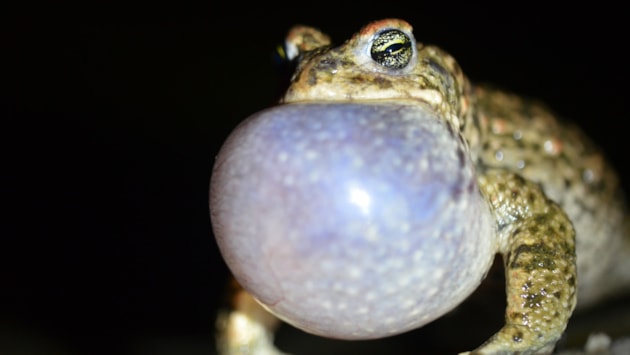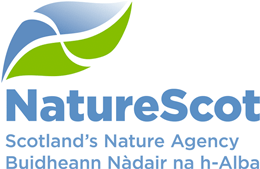07 May, 2025
Have you heard this toad?

Wildlife charity Amphibian & Reptile Conservation (ARC) and conservation programme Species on the Edge are asking residents of the Scottish Solway coast if they have heard the iconic call of Scotland's rarest amphibian, the natterjack toad.
The natterjack toad (Epidalea calamita) only occurs at a handful of locations in Scotland, all of which are along the Scottish Solway Coast. The species was once considered to be locally abundant in some coastal communities such as Powfoot, with residents having reported the village as sounding “as though it were in the tropics” during the spring and summer months.
The local natterjack population has declined dramatically in recent years, largely due to the loss of or damage to available habitat. Amphibian & Reptile Conservation and Species on the Edge are asking for information from anyone who thinks they might have heard the croaking of the natterjack toad in recent years. This information will help shape efforts to conserve the toad on the Solway coast.
Species on the Edge, funded by The National Lottery Heritage Fund, is a partnership of eight conservation organisations in Scotland working together and with communities across the country to secure a future for Scotland’s rarest and most vulnerable coastal species – including the natterjack toad.
The natterjack toad can be distinguished from the common toad (Bufo bufo) by the distinctive yellow stripe that runs along its back. It is also unique in its ability to produce a loud rasping call that can be heard from up to a kilometre away under optimal conditions. Male toads call to attract a mate during the breeding season, which usually starts in April and can run until July.
The natterjack toad is known to thrive in dynamic and changeable habitats such as sand dunes and saltmarsh (or “merse”), the likes of which are threatened by natural processes such as sea level rise and coastal erosion. The species is also thought to have been negatively impacted by agricultural intensification, forestry activity and urbanisation.
The species tends to lay its spawn in shallow, temporary water bodies that usually either dry up by later summer or are filled with sea water during spring high tides. This means that natterjack habitat is very susceptible to fluctuations in local weather patterns such as prolonged periods of drought or severe winter storms. In our changing climate, such weather fluctuations are becoming more frequent.
Species on the Edge Project Officer for the Solway Coast, Liam Templeton, said: “The natterjack toad is an incredibly rare and charismatic species that we are fortunate enough to have associated with our Scottish Solway Coast. It is beloved by the communities with whom it shares its surroundings, and its disappearance from the Solway coast would be a tragic loss to the cultural identity of these places. Those communities now have an opportunity to play an important role in helping to inform efforts to conserve the species, and I’m committed to using my role to empower them with the skills and confidence to make meaningful contributions to species recovery.”
Those who have heard the toad are asked to send the date, time and location of where the toad was heard, and if possible an audio recording, to sote@arc-trust.org. For more information on the natterjack toad and how to help it, please visit www.speciesontheedge.co.uk or www.arc-trust.org.
The natterjack toad is protected under UK and European law. It is a criminal offence to cause disturbance to the species or its habitats, including handling or photographing of the animal, without special licensing or permission granted by the relevant statutory agency (NatureScot in Scotland).
Contact information
- Name
- Eilidh Ross
- eilidh.ross@nature.scot
Notes to editors
For further information or to arrange an interview, please contact:
Name: Liam Templeton, Species on the Edge Project Officer
Email: liam.templeton@arc-trust.org
Mobile: 07747270581
Species on the Edge is a multi-partner species conservation programme dedicated to working with communities across Scotland’s coasts and islands to help them secure a future for their local vulnerable and threatened wildlife. Funded by The National Lottery Heritage Fund, the partnership consists of Amphibian and Reptile Conservation, Bat Conservation Trust, Buglife, Bumblebee Conservation Trust, Butterfly Conservation, NatureScot, Plantlife, and RSPB Scotland. The programme is active across seven landscape-scale areas in Scotland: Argyll and the Inner Hebrides; Outer Hebrides; North Coast; Orkney; Shetland; East Coast; Solway Coast.
For more information visit https://speciesontheedge.co.uk/
Amphibian and Reptile Conservation (ARC) is a national wildlife charity focusing on toads, frogs, newts, snakes, lizards and marine turtles. ARC conserves amphibians and reptiles, and the habitats on which they depend, to protect them for future generations. The Trust runs species recovery programmes, monitoring, scientific research, advocacy, outreach and regional projects. ARC owns 24 nature reserves and manages 80, covering 1,900 hectares, and works with a wide range of partner organisations, volunteers and specialists. ARC continues a 50-year history of reptile and amphibian conservation. The charity was established in June 2009 by the Herpetological Conservation Trust (HCT), which was formed in 1989. HCT grew out of the British Herpetological Society’s Conservation Committee, formed in 1969.
For more information visit www.arc-trust.org
a: 744 Christchurch Road, Boscombe, Bournemouth, Dorset, BH7 6BZ
t: 01202 391319
NatureScot is Scotland's nature agency. We work to enhance our natural environment in Scotland and inspire everyone to care more about it. Our priority is a nature-rich future for Scotland and an effective response to the climate emergency. For more information, visit our website at www.nature.scot or follow us on X at https://x.com/NatureScot
’S e NatureScot buidheann nàdair na h-Alba. Bidh sinn a’ neartachadh àrainneachd na h-Alba agus a’ brosnachadh dhaoine gu barrachd suim a chur ann an nàdar. Tha e mar phrìomhachas againn gum bi nàdar na h-Alba beairteach agus gun dèilig sinn gu h-èifeachdach le èiginn na gnàth-shìde. Tha an tuilleadh fiosrachaidh aig www.nature.scot no air X aig https://x.com/NatureScot






